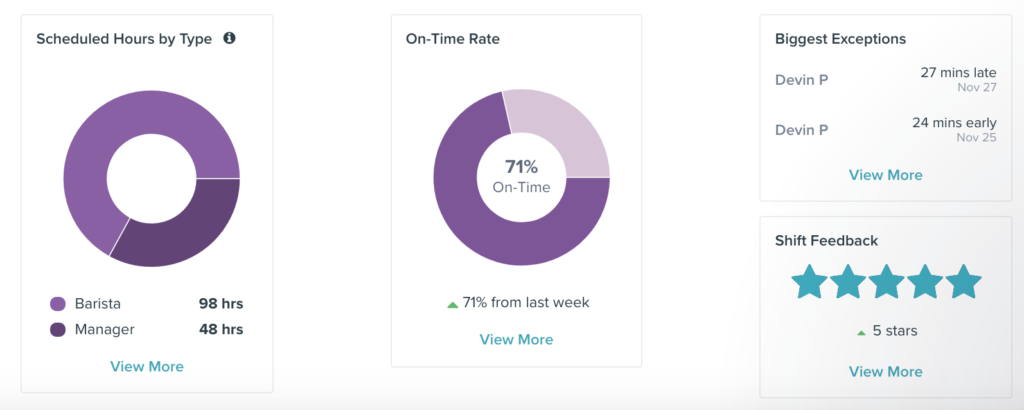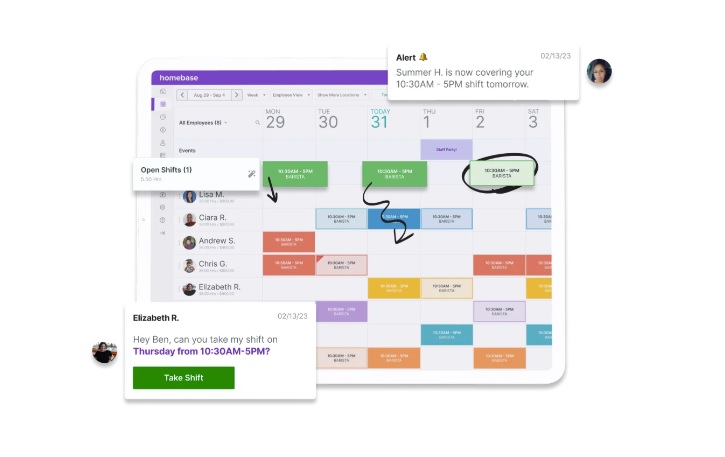Companies of all sizes need productive teams. But when you’re running a small business with tight margins, it can mean the difference between thriving and struggling to stay afloat.
Picture two local eateries. Restaurant A is always buzzing. Orders go out on time, there’s a great atmosphere, and customers turn into regulars. Now think about Restaurant B just down the block. Here, orders get mixed up, the kitchen often runs out of popular items, and staff clock in late and perform poorly.
You can bet that Restaurant A is gaining customers and improving its bottom line, while Restaurant B is losing clients and money.
The difference between them? Employee productivity. Both teams are putting in the same number of hours — but only the productive team turns those hours into sales and customer satisfaction.
If you’re dealing with an inefficient team, don’t worry. You can avoid the path of Restaurant B by using this guide to boost your people’s productivity and set your small business on the path to success.
Why is employee productivity important for small businesses?
In a small business, your employees are your greatest assets. Labor costs are often one of the biggest expenses for SMBs, and when budgets are tight, you need to make sure that translates into great results.
Here are five key reasons why employee productivity matters:
1. Cost efficiency
Basically, productive employees get more done with the same amount of time. That means more tasks completed, more customers served, and more clients helped. Efficient teams also tend to make fewer mistakes, resulting in less time and money spent correcting errors.
2. Profitability
Higher productivity helps maximize your output — and the more goods and services you can provide, the higher your revenue potential. Higher sales means higher revenue, which you can reinvest in growing your business.
3. Customer experience
Small businesses need to offer great customer service — and employee productivity is what makes this possible. Productive workers keep lines moving, handle issues quickly, and process transactions efficiently. Short wait times and effective service will keep customers coming back over time.
4. Morale
Productivity and employee morale often go hand-in-hand. Productive teams are more engaged, and that positive attitude creates a great working environment and a pleasant atmosphere for customers.
5. Time
Let’s say you own a coffee shop, and a barista manages to cut down the average order processing time by just a minute per customer due to their great organization. Multiply that by the hundreds or even thousands of customers you serve each week, and you’ve saved hours of labor. That’s time that can now go to valuable activities like customer engagement or improving your systems.
The 7 best ways to improve team productivity
Now that we’ve established the importance of productivity, let’s explore how to enhance your team’s output. We’ll guide you through seven proven steps to improve productivity levels in your business, complete with actionable tips you can start using today.
1. Assess current productivity levels
Before you can improve, you need to know where you stand. Start by evaluating how your team currently spends their time so you can identify areas of improvement.
You can do this manually by listing daily, weekly, and monthly tasks and talking to employees and managers about their experiences. Are there bottlenecks? Are some employees frequently standing around while others are swamped?
Tools like Homebase let you avoid the time sink of manual productivity tracking. Homebase gives you an overview of team performance by tracking metrics like employee attendance, on-time rates, and clock in times so you can see where you’re losing time. You can also log notes on employee performance directly on your roster.

| Pro tip: Don’t forget the human element. Productivity numbers give you important information, but you’ll also need to understand how your people feel. Organize quick one-on-one meetings, send out quick team chat messages, or gather shift feedback from employees with Homebase. |
2. Focus on the most important tasks
By prioritizing effectively, you can prevent your team from getting lost in busy work and make sure the most critical aspects of your business get the attention they need.
Start by defining the main tasks your employees do on a regular basis. Then, group tasks into categories like urgent, important, and optional.
- Urgent tasks are those that require immediate action — maybe there’s a customer waiting or a tight deadline for filing paperwork.
- Important tasks are important activities that are vital for the success of your business, but less pressing.
- Optional tasks are jobs that don’t directly impact revenue and customer satisfaction.
Imagine a small clothes store that’s looking to improve productivity on inventory processes. A time-pressed manager should focus on reordering fast-selling, out-of-stock items (urgent and important). The next priority should be planning ahead to order popular items that aren’t yet out of stock (important, but not urgent). Spending time on ordering new product lines might be an optional task that can be left until later.
Basically, make sure your staff prioritize tasks that are urgent and important. Then, encourage them to focus on important but less urgent work. Create a culture where teams engage in optional tasks only when there’s time to spare.
For more detailed time management advice, take a look at our timeboxing tips and guide on using the Eisenhower Matrix for time management.
3. Make your business a great place to work
A positive work environment motivates your team, which reduces turnover and makes them more likely to go the extra mile.
Boost employee happiness by:
- Encouraging open communication with team meetings, regular check-ins, and opportunities for employees to give feedback
- Creating a pleasant workspace with comfortable furniture, good lighting, and maybe even plants
- Using a personal touch — it means a lot to employees when you shout out their hard work or remember their birthdays or work anniversaries (tools like Homebase can remind you of these milestones!)
- Offering perks where possible, like flexible working hours or even early access to their wages.
4. Streamline scheduling
Every minute counts when you’re managing a small business. Proper employee scheduling ensures that you have the right people in the right places at the right times, which cuts down on confusion and paying for unnecessary overtime.
For effective scheduling, plan rosters well ahead of time so employees can make plans and scheduling conflicts can be ironed out in advance. Make sure you schedule enough staff for peak business hours and be mindful of qualifications and experience levels — make sure brand new team members aren’t left alone during your busiest times, for example.
Homebase scheduling makes it simple to optimize your team’s timetable. The app lets you automate scheduling based on team availability and time off requests. You can also adapt as you go, easily finding last-minute cover for shifts and sending updates to all the team members affected.

5. Improve your communication
Clear, efficient communication helps teams get things done and avoid mistakes, misunderstandings, and delays.
Here’s how to do it:
- Give clear objectives and instructions. Where possible, refer staff to shared written guidelines like an employee handbook so everyone’s on the same page.
- Make your meetings effective by creating an agenda in advance so you don’t go off track.
- Have a process in place for resolving conflicts that may arise and address issues quickly and before they escalate.
- Simplify team communication with easy-to-use tools where people can quickly send messages to individuals or groups and receive automated reminders that cut down on misunderstandings and no-shows.
6. Celebrate and reward achievements
Recognizing jobs well done is essential for a positive work culture. Celebrating achievements motivates the team to strive for excellence.
Show your appreciation with an Employee of the Month program or spot bonuses for exceptional performance. Rewards don’t have to be financial — praise employees with shout outs or get creative with perks like a prime parking spot, a personalized certificate, or a featured spot on the company website or newsletter.
A study by the Society for Human Resource Management (SHRM) found that employees whose achievements are recognized are more satisfied, leading to better performance across the team.
7. Optimize hiring and onboarding
Hiring the best people and getting them up to speed quickly has a huge impact on team productivity.
Make sure you write clear, detailed job descriptions and implement a structured interview process that evaluates both skills and cultural fit. Also, put some thought into onboarding. Create a well-designed company orientation that includes training, mentorship, and even a buddy system.
Hire smart by using small business-friendly recruitment tools that identify the best candidates with screening questions and track all your applicants in one place. Homebase hiring can help you with all of that and more, so you’ll bring new hires on board more quickly and get them working productively sooner.
Maximize your small business team’s potential with Homebase
Improving your team’s performance can be a game-changer for small businesses. But without the right tools, productivity strategies can take valuable time from managers and business owners.
Homebase is an all-in-one tool that’s designed to address the unique productivity challenges small businesses deal with.
Homebase helps you track productivity metrics like attendance and punctuality so you can see where you’re losing time. Scheduling features keep your operations running smoothly, and the communication app helps keep the team aligned, recognize and motivate your people, and welcome new employees.
By using Homebase to harness the full potential of your team, you can keep your employees happy and your company thriving.
FAQs about improving employee productivity
What is employee productivity?
Employee productivity describes the value your employees generate within their working hours. Put simply, it’s the amount of good work your team gets done. The better your team performs, the more your business grows. Productive employees have a positive impact on business outcomes like revenue, return on investment (ROI), and profitability.
How do you measure employee productivity?
There are several ways to measure employee productivity. One way is to set clear goals (often called Key Performance Indicators or KPIs) and then track how well your team is meeting them. These could be things like how happy your customers are with their service or how quickly team members finish tasks or projects.Another way is to compare how many hours employees work compared to how many tasks they complete (and how well they do so). For a shift-based business, you might use a time clock to stay on top of how many hours team members are working and implement checklists to ensure employees are getting all their essential work done.
What is the best management style to increase productivity?
The best management style to increase productivity varies depending on your unique business and team.
Democratic management styles tend to increase team motivation, which can boost performance. Affiliative management styles can create a positive work environment, which improves employee morale. However, some teams and workplaces respond well to more authoritative management styles that provide clear direction and concrete goals.
Ultimately, an effective manager can adapt their management style to changing team and company needs. The best managers prioritize, streamline tasks, communicate well, and engage employees to improve productivity.
